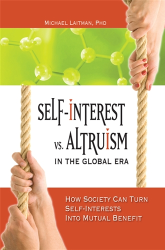Two Essential Desires Every Truth Seeker Needs to Find
The importance of Abraham’s discovery lies not so much in its scientific or conceptual innovation, although for his time both were absolutely radical. Rather, the primary significance of his discovery lies in its social aspect.
Indeed, Abraham’s motivation for asking the questions about life’s meaning and purpose, which eventually led to his discovery, was as much social as it was intellectual. He noticed that his townspeople were becoming increasingly alienated. For a long time, Babylonians nurtured a prosperous society that allowed multiple belief systems and teachings to coexist in harmony. But in Abraham’s time, people were growing intolerant, conceited, and alienated from each other, and Abraham wondered why.
Through his questions and observation of Nature, he realized that the world that appears to our senses is but a superficial blanket that covers a complex and magnificent interaction of forces. When these forces interweave in a certain way, they induce a certain type of physical or emotional reality to appear, such as birth, death, war, peace, and all the states in between.
This interaction exists not only on a large scale, as between countries, but in every element of life, from the subatomic to the interstellar, and from the very personal to the international.
Abraham’s thought process in discovering these forces is evident in his questions, which to him were, as Neil Postman put it in The End of Education, “the principal intellectual instruments available to human beings.” In Maimonides’ writings, Abraham asked, “How was it possible for this wheel [of reality] to always turn without a driver? Who is turning it, for it cannot turn itself?”
Thus, through repeated pondering and observation, Abraham came to realize what really makes the world go around, and like all great truths, it was as simple as can be: desires, two desires, to be exact. One is a desire to give and the other, to receive. The interaction between those desires is what makes the world go around; it is the wheel that drives all things and the force that creates all phenomena. In Kabbalistic terminology, the desire to give is referred to as “His [the Creator’s] desire to do good to His creations,” and the desire to receive is described as “the desire and craving to receive delight and pleasure.” for short, Kabbalists refer to them as “desire to bestow” and “desire to receive.”
This simple realization is what Abraham was trying to convey to his fellow Babylonians, but Nimrod tried to prevent him from doing so by trying to kill him. And when he failed to do so, he sent him away.
The Secret Rules Abraham Discovered of Preventing Potential Destruction
Alas, deporting Abraham did not restore the Babylonian spirit of camaraderie and union. Eventually, “The Lord [Creator, meaning Nature] confused the language of the whole earth; and from there the Lord scattered them abroad over the face of the whole earth” (Gen, 11:9).
This did not happen to the Babylonians because some vengeful and powerful old man called “The Lord” was holding a grudge against them. It happened to them because the desires that Abraham discovered possess a certain direction of evolution. There is no random interaction here, but a set of rules that unfold by a rigid cause-and-effect order.
When Abraham discovered these rules, he realized his local folk were headed in the wrong direction, which could only lead them to eventual destruction, so he tried his best to warn them. As we will see, these desires are as perpetual and as rigid as gravity, or the positive and negative poles of a magnet. But like gravity and the poles of the magnet, both forces can be made to work to our benefit.
To understand the similarity between the current state of humanity and the state of the Babylonian society, and hence the relevance of Abraham’s discovery to the current global crises, we need to understand the direction in which the two desires evolve. And for this, we need to start from the very beginning.
How to Discover the Force that Operates Your Desires … Like a Kabbalist
In his book, The Tree of Life, the great 16th century Kabbalist Isaac Luria (the Ari), founder of Lurianic Kabbalah, today’s predominant school of Kabbalah, wrote, “Know, that before the emanations were emanated and the creatures created, an Upper, Simple Light had filled the whole of reality. And there was no vacant place, such as an empty air and a void, but everything was filled with that simple, boundless Light.”
Since then, only one Kabbalist has ventured to compose a comprehensive explanation of these profound phrases, as well as introduced a complete commentary on The Zohar: Kabbalist Rav Yehuda Ashlag, Baal HaSulam. In his six-volume commentary on the writings of the Ari, known as Talmud Eser Sefirot (The Study of the Ten Sefirot), Baal HaSulam explains that the Light that the Ari refers to is “All the pleasant sensations and conceptions in the world.” He also defines “Light” as “everything but the substance of the vessels [desire to receive].”
In other words, there are only two “beings” in existence: the desire to bestow, to give, which Ashlag defines as “light,” “Creator,” or “pleasure,” and the desire to receive pleasure, to enjoy, which he calls “a vessel,” “the creature,” or “the created being.” To understand how the whole of reality can emerge from only two desires, we need to take a deeper look at how they interact.
Electricity, gravity, and all of Nature’s other forces are timeless phenomena. In other words, you cannot point to a specific point in time at which they were created because Nature’s forces are not particular events; they are potentials or fields that cover the whole of space-time. They manifest under certain conditions and, given the right instruments, we can detect their existence.
To prove the existence of electricity, you need a resistor of some sort, like a lamp or a current-meter. Without something that resists the flow of the electric current, we could never know that electricity was flowing through it, and we could never discover the existence of electricity. Similarly, to prove the existence of gravity, we need to observe its effect on physical masses, and to discover light, we need an object that the light illuminates, meaning stops the light and reflects it back to our eyes.
In precisely the same way, Kabbalists discovered the desire to bestow through that desire’s interaction with its resistor—their own desires to receive. When they refined and calibrated their resistors—desires to receive—they were able to detect the force that operated those desires. That was how Abraham discovered that the force that operated his desires and the rest of reality was a desire to bestow. This is the knowledge that Abraham passed on to his sons and students, and this is still the knowledge that Kabbalists pass on from teacher to student, and now to the entire world.
Kabbalist Yehuda Ashlag’s Keys to Understanding Abraham’s Stories Rationally
In his Study of the Ten Sefirot, Ashlag tells us that this desire to bestow created the desire to receive as a necessary offshoot of its wish to bestow. In other words, because the desire is a desire to give, it created something that wishes to receive. Thus, just as it is impossible to explain what is a day without also understanding what is a night, or to understand the concept of “left side” without having the concept of “right side” either, it is impossible to perceive the desire to receive without perceiving the desire to give.
To put matters in the right context, when Kabbalists speak of the Creator, they are referring to the desire to give, and when they speak of Creation, they are referring to the desire to receive the Creator’s giving. Also, when they are presenting a dialog between the Creator and the creatures, such as we find in the Bible, they are actually introducing a specific interaction between the desire to give and the desire to receive, not an exchange of vocalisms between a protein aggregate and a voice in the clouds.
In that regard, at the conclusion of his “Introduction to The Study of the Ten Sefirot” (Item 156), Ashlag takes special care to warn us:
“Yet, there is a strict condition during the engagement in this wisdom—to not materialize the matters with imaginary and corporeal issues. This is because thus they breach, ‘Thou shall not make unto thee a graven image, nor any manner of likeness.’ … To rescue the readers from any materialization, I composed the book, The Study of the Ten Sefirot by the Ari, where I collect from the books of the Ari all the principal essays concerning the explanation of the ten Sefirot in as simple and easy language as I could.”
Thus, at the basis of existence lies not matter, but forms of desire to receive pleasure created by interactions with their Creator—the desire to give pleasure.
To tie this approach to more familiar territory, think of lightning. To the ancient Greeks, the thunderbolt was Zeus’ traditional weapon. To us, the exact same thunderbolt is merely “The visible discharge of electricity that occurs when a region of a cloud acquires an excess electrical charge that is sufficient to break down the resistance of air,” if we consult the Encyclopedia Britannica.
Similarly, understanding the true meaning of Abraham’s story requires an explanation by one who has acquired sufficient knowledge to explain it in a matter-of-fact, rational manner, meaning a Kabbalist, and preferably one of substantial understanding and sufficient didactic skills, such as Ashlag.
This is why today, Kabbalist Yehuda Ashlag’s books are the most suitable for those who wish to delve deeper into the true “grand, unified theory of everything” – the wisdom of Kabbalah.
 “How to Discover the Force that Operates Your Desires … Like a Kabbalist” is based on the book, Self Interest vs. Altruism in the Global Era: How Society Can Turn Self Interests into Mutual Benefit by Dr. Michael Laitman.
“How to Discover the Force that Operates Your Desires … Like a Kabbalist” is based on the book, Self Interest vs. Altruism in the Global Era: How Society Can Turn Self Interests into Mutual Benefit by Dr. Michael Laitman.

